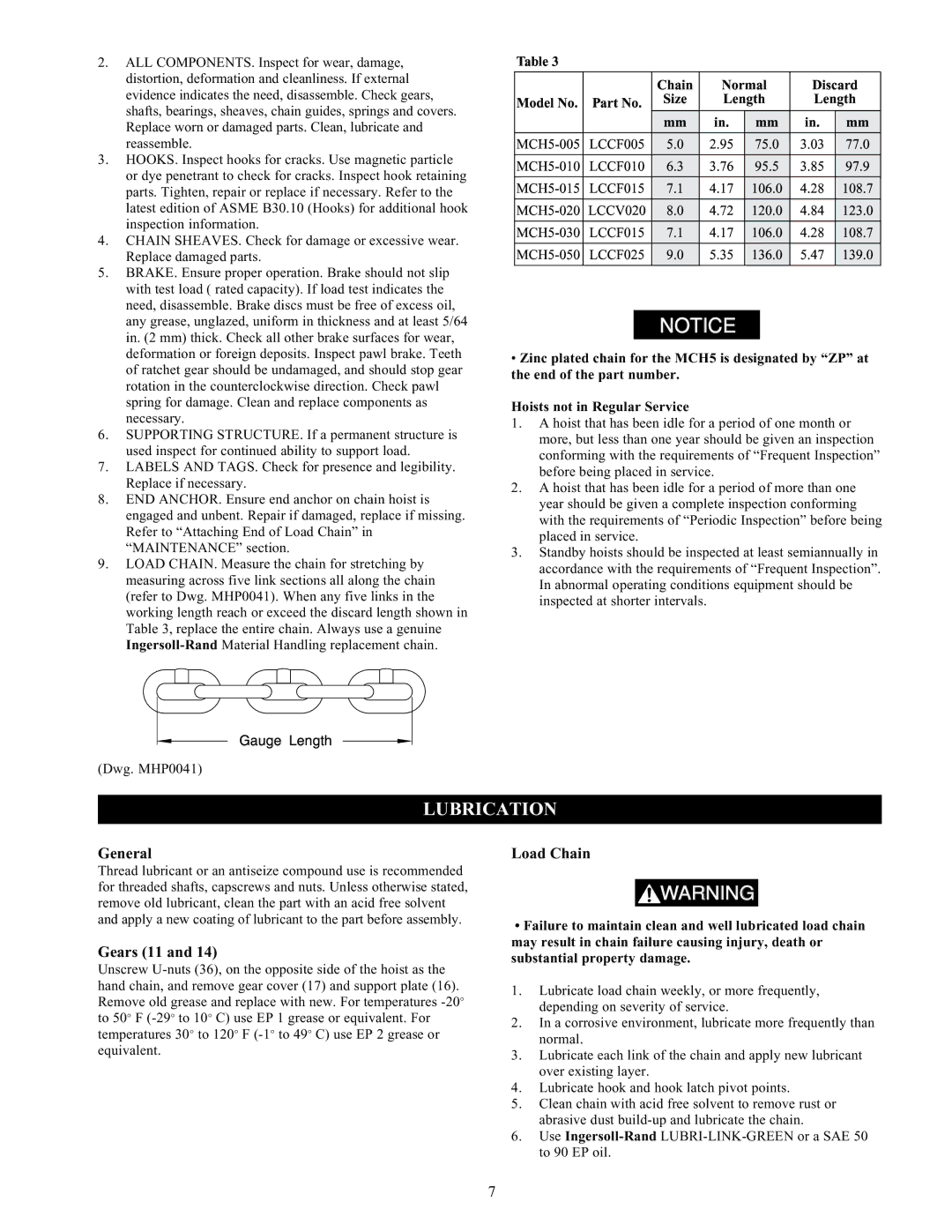
2.ALL COMPONENTS. Inspect for wear, damage, distortion, deformation and cleanliness. If external evidence indicates the need, disassemble. Check gears, shafts, bearings, sheaves, chain guides, springs and covers. Replace worn or damaged parts. Clean, lubricate and reassemble.
3.HOOKS. Inspect hooks for cracks. Use magnetic particle or dye penetrant to check for cracks. Inspect hook retaining parts. Tighten, repair or replace if necessary. Refer to the latest edition of ASME B30.10 (Hooks) for additional hook inspection information.
4.CHAIN SHEAVES. Check for damage or excessive wear. Replace damaged parts.
5.BRAKE. Ensure proper operation. Brake should not slip with test load ( rated capacity). If load test indicates the need, disassemble. Brake discs must be free of excess oil, any grease, unglazed, uniform in thickness and at least 5/64 in. (2 mm) thick. Check all other brake surfaces for wear, deformation or foreign deposits. Inspect pawl brake. Teeth of ratchet gear should be undamaged, and should stop gear rotation in the counterclockwise direction. Check pawl spring for damage. Clean and replace components as necessary.
6.SUPPORTING STRUCTURE. If a permanent structure is used inspect for continued ability to support load.
7.LABELS AND TAGS. Check for presence and legibility. Replace if necessary.
8.END ANCHOR. Ensure end anchor on chain hoist is engaged and unbent. Repair if damaged, replace if missing. Refer to “Attaching End of Load Chain” in “MAINTENANCE” section.
9.LOAD CHAIN. Measure the chain for stretching by measuring across five link sections all along the chain (refer to Dwg. MHP0041). When any five links in the working length reach or exceed the discard length shown in Table 3, replace the entire chain. Always use a genuine
NOTICE![]()
![]()
•Zinc plated chain for the MCH5 is designated by “ZP” at the end of the part number.
Hoists not in Regular Service
1.A hoist that has been idle for a period of one month or more, but less than one year should be given an inspection conforming with the requirements of “Frequent Inspection” before being placed in service.
2.A hoist that has been idle for a period of more than one year should be given a complete inspection conforming with the requirements of “Periodic Inspection” before being placed in service.
3.Standby hoists should be inspected at least semiannually in accordance with the requirements of “Frequent Inspection”. In abnormal operating conditions equipment should be inspected at shorter intervals.
(Dwg. MHP0041)
LUBRICATION
General
Thread lubricant or an antiseize compound use is recommended for threaded shafts, capscrews and nuts. Unless otherwise stated, remove old lubricant, clean the part with an acid free solvent and apply a new coating of lubricant to the part before assembly.
Gears (11 and 14)
Unscrew
Load Chain
![]()
![]() WARNING
WARNING
•Failure to maintain clean and well lubricated load chain may result in chain failure causing injury, death or substantial property damage.
1.Lubricate load chain weekly, or more frequently, depending on severity of service.
2.In a corrosive environment, lubricate more frequently than normal.
3.Lubricate each link of the chain and apply new lubricant over existing layer.
4.Lubricate hook and hook latch pivot points.
5.Clean chain with acid free solvent to remove rust or abrasive dust
6.Use
7
